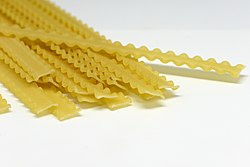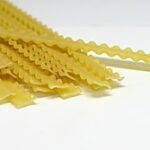How to Cook Traditional Mafalde Pasta: A Comprehensive Guide
Mafalde pasta also known as mafalde is a traditional Italian pasta that brings both elegance and authenticity to any meal. Recognizable for its wide, ruffled edges, Mafalde holds its shape wonderfully when cooked and pairs exceptionally well with a variety of sauces, from rich ragù to light seafood.
While it is sometimes overlooked in favor of more popular pastas like spaghetti or penne, Mafalde is a true culinary gem that deserves a spot in your pasta repertoire. In this article, we’ll take you step by step through the process of cooking Mafalde pasta, from selecting the best ingredients to serving it with the perfect sauce.
What is Mafalde Pasta?
Mafalde pasta is a flat, ribbon-like pasta with wavy, ruffled edges. It is named after Princess Mafalda of Savoy, the daughter of King Victor Emmanuel III of Italy. According to Italian culinary history, the pasta was crafted in her honor, and it became popular in Southern Italy and beyond, particularly in Naples and Sicily.
This pasta’s wide, ribbed texture makes it ideal for holding sauces. The ruffled edges allow the pasta to “catch” the sauce, creating a perfect balance between the pasta and whatever sauce you choose to serve it with. Mafaldin is often confused with other similarly shaped pasta, such as pappardelle or fettuccine, but its distinctive ruffled edge is what sets it apart.
Selecting the Right Mafalde Pasta
While fresh Mafalde can often be found in Italian delis and specialty markets, most home cooks will typically use dried Mafalde pasta. When selecting dried Mafalde, it’s essential to look for a high-quality product to ensure the best texture and flavor. Italian brands such as De Cecco, Rummo, or La Molisana are well-known for producing excellent pasta that retains its integrity when cooked, making it an ideal choice for your dishes.
Look for pasta made from durum wheat semolina, which is the traditional and best flour for pasta-making. Durum wheat semolina creates a firm, non-mushy pasta that stands up well to rich sauces. The drying process used for artisanal pasta can also play a significant role in the texture of the pasta, as slow drying at low temperatures allows the pasta to absorb sauce better.
Boiling Mafalde Pasta to Perfection
Cooking Mafalde is no different from preparing any other type of pasta, but the key to perfect Mafalde lies in timing and water ratios.
Boil Plenty of Water: Use a large pot with plenty of water to cook the pasta. The general rule of thumb is to use about 4-6 quarts of water per pound of pasta. This ensures that the pasta has enough space to move around and cook evenly.
Add Salt: Salt your water generously once it comes to a boil. Aim for about 1-2 tablespoons of salt per pound of pasta. Salt is crucial for flavor and helps the pasta maintain its seasoning throughout the cooking process.
Add the Mafalde: Once the water is boiling and salted, add the Mafalde to the pot. Stir gently to prevent the pasta from sticking together, especially since mafaldine’s flat, wide shape can make it more prone to clumping. Give it a few seconds to loosen up.
Cooking Time: Mafalde generally takes about 10-12 minutes to cook to al dente. Check the package for exact cooking times, as different brands and thicknesses may vary slightly. For the best texture, taste a piece a minute or two before the suggested cooking time is over to ensure it’s cooked to your liking.
Do Not Overcook: As with all pasta, Mafalde should be cooked al dente, meaning it should still have a slight firmness when bitten. Overcooking pasta will result in a mushy texture and less ability to hold sauce.
Draining and Reserving Pasta Water
Once the mafaldine has finished cooking, it’s time to drain the pasta. But before you do so, be sure to reserve about a cup of pasta cooking water. This starchy water can be used to adjust the consistency of your sauce, as it helps to bind the sauce to the pasta.
To drain the pasta, simply pour it through a colander, but avoid rinsing it under cold water. Rinsing pasta removes the starches that help the sauce stick, which can lead to a less flavorful dish. Instead, allow the pasta to retain its natural starch while you prepare to toss it with your sauce.
Choosing the Perfect Sauce for Mafaldine
One of the great things about mafaldine pasta is that its wide, ruffled edges make it suitable for a variety of sauces. Here are a few classic options that pair exceptionally well with mafaldin:
Ragù alla Bolognese: Mafaldine’s broad shape and ridged edges make it a perfect choice for hearty, meat-based sauces like ragù alla Bolognese. The sauce clings to the pasta, creating a rich and comforting dish. The ruffles add an extra layer of texture, making each bite satisfying.
Pesto: The wavy edges of mafaldine work beautifully with both fresh basil pesto and sun-dried tomato pesto. The ruffled texture holds the pesto, making each bite full of flavor. You can enhance the pesto by adding a sprinkle of Parmesan cheese or some toasted pine nuts for crunch.
Seafood Sauces: Mafaldine can also pair wonderfully with light seafood sauces, especially those made with shrimp, clams, or mussels. The texture of the pasta complements the delicate flavors of the seafood, while the ridges catch the seafood juices, allowing the pasta to absorb the flavors.
Tomato-based Sauces: A classic tomato sauce, especially one that is rich with garlic, onions, and fresh herbs, can be elevated by the texture of mafaldine. The sauce will adhere to the ruffled edges, making each bite a flavorful experience.
Creamy Sauces: For a luxurious twist, mafaldin works well with creamy sauces like Alfredo or a simple carbonara. The ruffled pasta is able to hold onto the sauce more effectively than traditional smooth pasta shapes, making for a satisfying mouthful of rich, creamy goodness.
Tossing the Pasta with Sauce
Once you’ve selected your sauce, it’s time to bring everything together. Here’s how to properly toss mafaldine with sauce for a perfect result:
Heat the Sauce: Make sure your sauce is heated thoroughly before adding the cooked pasta. If your sauce has been sitting for a while, warm it gently over medium heat while stirring to prevent it from burning.
Combine the Pasta and Sauce: Once the sauce is hot and your mafaldin is drained (but not rinsed), add the pasta to the sauce. Toss gently, ensuring that each piece of pasta is coated with the sauce. If your sauce is too thick or needs some extra help sticking to the pasta, add a little of the reserved pasta water to adjust the consistency. The starchy pasta water will help emulsify the sauce, making it smooth and velvety.
Final Seasoning: Taste the pasta once it’s tossed with the sauce and adjust the seasoning as needed. A pinch of salt, a dash of freshly cracked pepper, or a sprinkle of Parmesan can go a long way in bringing out the flavors.
Serving Mafaldine Pasta
The final step is to plate your mafaldine pasta. Since it’s a hearty and elegant pasta, it’s perfect for both casual meals and special occasions. Consider garnishing your dish with freshly chopped herbs like basil or parsley, a dusting of Parmesan cheese, or a drizzle of olive oil for added flavor and presentation.
If you’re serving mafaldin as part of a multi-course meal, you can pair it with a light appetizer, such as a Caprese salad, or a refreshing dessert, like panna cotta or tiramisu. A glass of wine is also a perfect addition, with white wines like Pinot Grigio or a light red such as Chianti being good choices to complement the flavors of the pasta.
Conclusion: Mastering the Art of Mafaldine
Cooking traditional mafaldine pasta is an enjoyable and rewarding process that brings the flavors of Italy into your kitchen. By choosing the right pasta, cooking it to the perfect al dente texture, and pairing it with a sauce that complements its texture, you can create a truly delicious dish that will impress your family and friends. Whether you choose a rich ragù, a fresh pesto, or a light seafood sauce, mafaldine’s unique ruffled edges ensure that every bite is full of flavor. With these simple tips and techniques, you’ll be well on your way to mastering the art of cooking mafaldin pasta and enjoying a true Italian culinary experience. Buon appetito!





